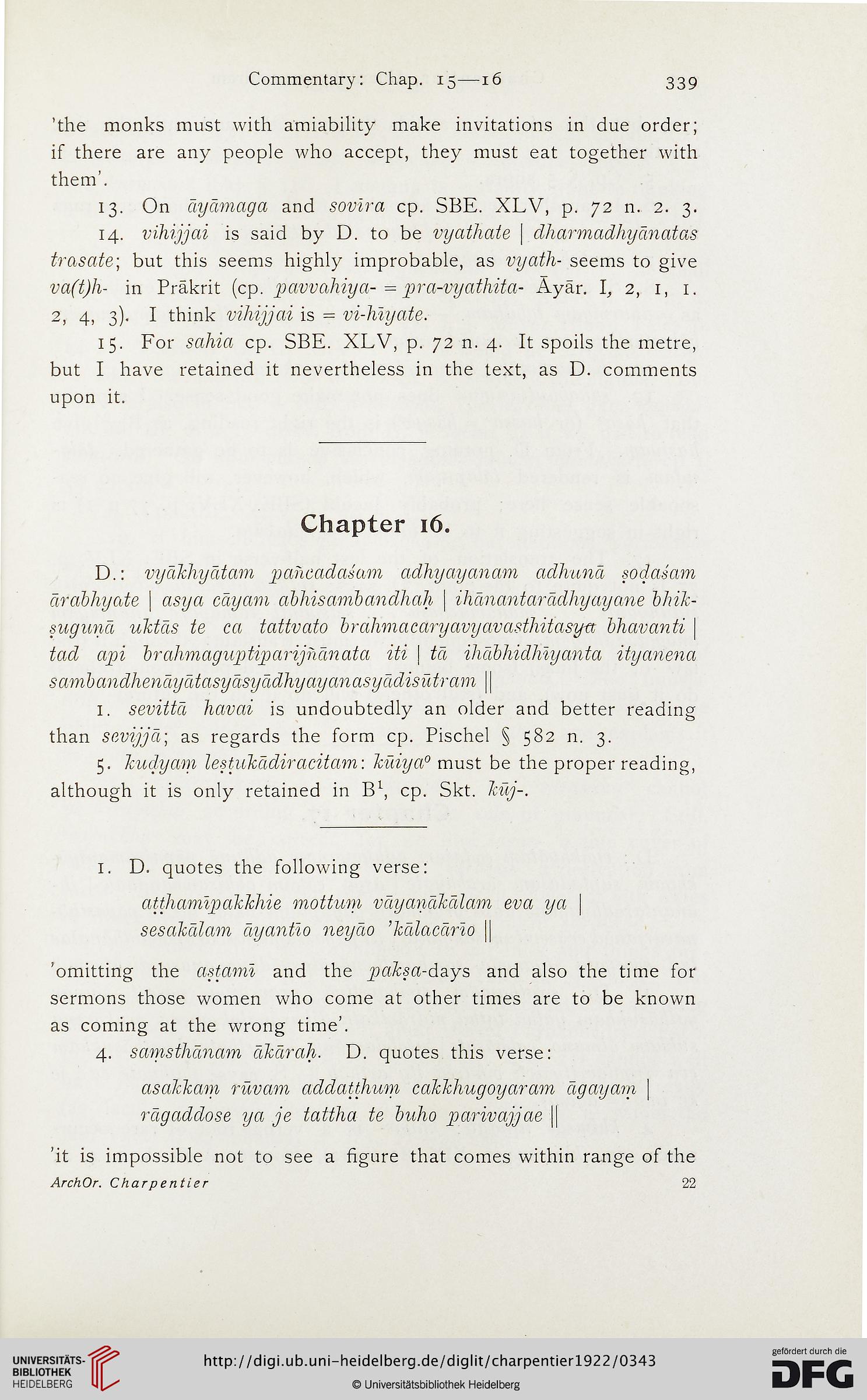Commentary: Chap. 15—16
339
’the monks must with amiability make invitations in due order;
if there are any people who accept, they must eat together with
them’.
13. On dydmaga and sovira cp. SBE. XLV, p. 72 n. 2. 3.
14. vihijjai is said by D. to be vyathate [ dharmadhydnatas
trasate; but this seems highly improbable, as vyath- seems to give
va(t)li- in Prakrit (cp. pavvahiya- = pra-vyathita- Ayar. I, 2, 1, 1.
2, 4, 3). I think vihijjai is = vi-hiyate.
15. For sahia cp. SBE. XLV, p. 72 n. 4. It spoils the metre,
but I have retained it nevertheless in the text, as D. comments
upon it.
Chapter 16.
D.: vyakliydtam paheadasam adhyayanam adhuna sodasam
drabhyate | asya cdyam abhisambandhah | ihdnantarddhyayane bhiJc-
sugund uktds te ca tattvato bralimacaryavyavasthitasytt bhavanti |
tad api brahmaguptiparijndnata iti | tci ihabhidhiyanta ityanena
sambandhendydtasydsycidhyayanasyddisutram ||
1. sevittd liavai is undoubtedly an older and better reading
than savijjd; as regards the form cp. Pischel § 582 n. 3.
5. Icudyam lestukddiracitam: kuiya0 must be the proper reading,
although it is only retained in B1, cp. Skt. hug-.
1. D. quotes the following verse:
atthamipakkhie mottum vdyandkdlam eva ya |
sesakdlam dyantio neydo ’kdlacdrio ||
’omitting the astami and the paJcsa-days and also the time for
sermons those women who come at other times are to be known
as coming at the wrong time’.
4. samsthdnam akdraJi. D. quotes this verse:
asalckam ruvam addatthum cakkliugoyaram dgayam \
rdgaddose ya je tattha te buho parivajjae ||
’it is impossible not to see a figure that comes within range of the
ArchOr. Charpentier 22
339
’the monks must with amiability make invitations in due order;
if there are any people who accept, they must eat together with
them’.
13. On dydmaga and sovira cp. SBE. XLV, p. 72 n. 2. 3.
14. vihijjai is said by D. to be vyathate [ dharmadhydnatas
trasate; but this seems highly improbable, as vyath- seems to give
va(t)li- in Prakrit (cp. pavvahiya- = pra-vyathita- Ayar. I, 2, 1, 1.
2, 4, 3). I think vihijjai is = vi-hiyate.
15. For sahia cp. SBE. XLV, p. 72 n. 4. It spoils the metre,
but I have retained it nevertheless in the text, as D. comments
upon it.
Chapter 16.
D.: vyakliydtam paheadasam adhyayanam adhuna sodasam
drabhyate | asya cdyam abhisambandhah | ihdnantarddhyayane bhiJc-
sugund uktds te ca tattvato bralimacaryavyavasthitasytt bhavanti |
tad api brahmaguptiparijndnata iti | tci ihabhidhiyanta ityanena
sambandhendydtasydsycidhyayanasyddisutram ||
1. sevittd liavai is undoubtedly an older and better reading
than savijjd; as regards the form cp. Pischel § 582 n. 3.
5. Icudyam lestukddiracitam: kuiya0 must be the proper reading,
although it is only retained in B1, cp. Skt. hug-.
1. D. quotes the following verse:
atthamipakkhie mottum vdyandkdlam eva ya |
sesakdlam dyantio neydo ’kdlacdrio ||
’omitting the astami and the paJcsa-days and also the time for
sermons those women who come at other times are to be known
as coming at the wrong time’.
4. samsthdnam akdraJi. D. quotes this verse:
asalckam ruvam addatthum cakkliugoyaram dgayam \
rdgaddose ya je tattha te buho parivajjae ||
’it is impossible not to see a figure that comes within range of the
ArchOr. Charpentier 22




